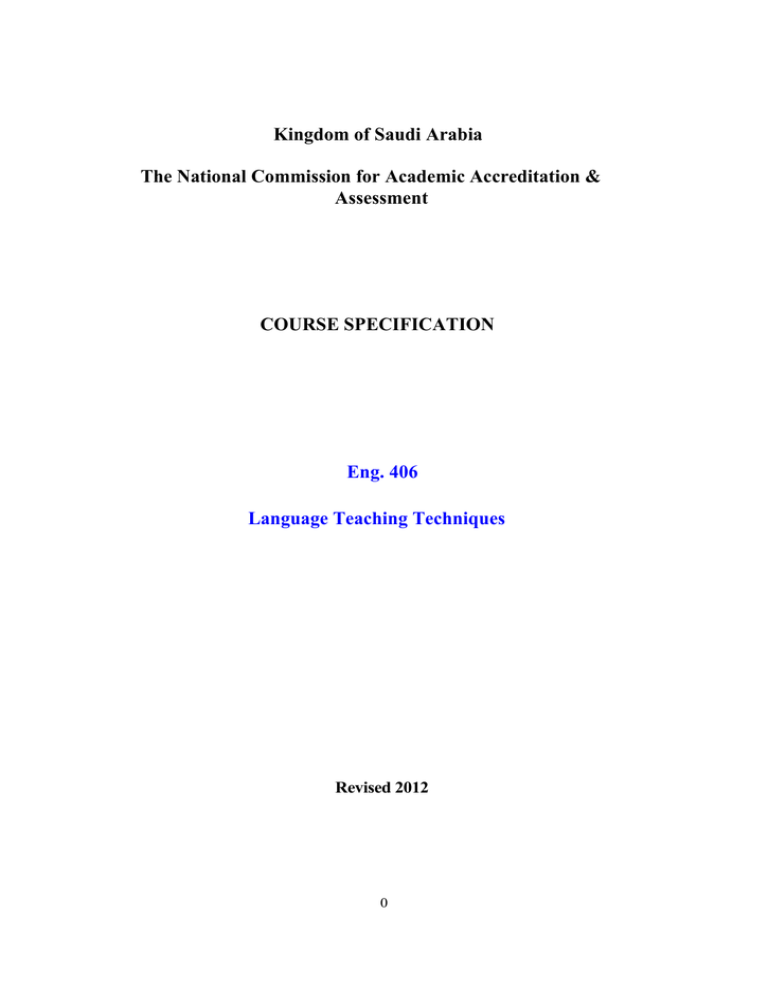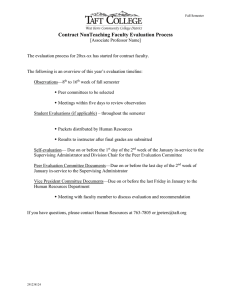
Kingdom of Saudi Arabia
The National Commission for Academic Accreditation &
Assessment
COURSE SPECIFICATION
Eng. 406
Language Teaching Techniques
Revised 2012
0
Course Specification
For Guidance on the completion of this template, please refer to
of Handbook 2 Internal
Quality Assurance Arrangements
Institution:
Majmaah University
College/Department:
College of Sciences and Humanities/ Department of English
A Course Identification and General Information
1. Course title and code:
Language Teaching Techniques: Eng. 406
2. Credit hours: 3 hours
3. Program(s) in which the course is offered.
(If general elective available in many programs indicate this rather than list programs)
B. A. English Language and Literature
4. Name of faculty member responsible for the course: Hanan Ahmed Sanad
5. Level/year at which this course is offered :
Level 6 /3rd year
6. Pre-requisites for this course (if any):
Preferably: Eng. 324
7. Co-requisites for this course (if any):
None
None
8. Location if not on main campus:
AlGhat
1
B. Objectives
1. Summary of the main learning outcomes for students enrolled in the course.
Students should be able to:
1. Identify a variety of language teaching methods and their underlying principles.
2. Explain the basic principles of the various teaching methods presented in the course
3. Apply the techniques presented.
4. Develop their own criteria to judge which techniques to use in a given situation
5. Apply different techniques to the four language skills.
6. Identify and use CALL computer assisted language learning techniques.
2. Briefly describe any plans for developing and improving the course that are being implemented. (eg
increased use of IT or web based reference material, changes in content as a result of new research in
the field)
1. Use online discussion group to complement work done in class.
2. Use additional text to improve course content.
C. Course Description (Note: General description in the form to be used for the Bulletin or Handbook should
be attached)
1 Topics to be Covered
Topic
No of
Weeks
Introduction
(Text: Larsen-Freeman)
Grammar Translation Method (background, principles, techniques)
(presentation on GTM)
Audio-lingual method (background)
Audio-Lingual Method (principles & techniques p.45-50)
(Presentation on ALM)
The direct method (earliest attempts at communication) p. 24-33
Direct Method (continued)
(presentation on Direct method)
The silent way p.53-71. (introduction)
The silent way (principles and techniques)
(presentation on the silent way)
Desuggestopedia p.73-86
(introduction, principles, techniques)
Presentation on desuggestopedia.
Communicative language teaching p.121-135
2
Contact
hours
1
week
3
hours
1
3
1
3
1
3
1
3
1
3
1
3
Communicative language teaching
Applying communicative activities to the language skills. (other
sources).
Presentation on the communicative approach.
Content based method p.137-142.
The whole language approach activities (p.142-143)
Content method presentation
Task based method p.144-150
Additional task based activities from other sources.
Presentation on task based.
Participatory approach p.150-155
Presentation on participatory approach
New methodological innovations:
Language learning strategies. P.159-164
Additional activities on strategies. Other sources.
Presentation on language learning strategies.
Applying multiple intelligences to the classroom. Multiple
intelligence lesson plan. P. 170.
1
3
1
3
1
3
1
3
1
3
1
3
(Text: Dudeney & Hockly.)
CALL: computer assisted language learning (introduction) p.7-14
Applications in computer lab
Internet based project work p.44-60
1
Suggested topics: Blogs p.86-92, e-learning (p.136-147)
Presentation on CALL
Review
1
(Note: Instructors may choose to have students do presentations at
the end of the semester, in which case they would be done during the
last week, and the review week if necessary)
3
3
2. Course components (total contact hours per semester):
Conference Style:
25 hours
Tutorial: None
In-class practice: 10
hours
Other: group work
10 hours
3. Additional private study/learning hours expected for students per week. (This should be an average :for the
semester not a specific requirement in each week)
6 hours and via email.
3
4. Development of Learning Outcomes in Domains of Learning
For each of the domains of learning shown below indicate:
� A brief summary of the knowledge or skill the course is intended to develop;
�
A description of the teaching strategies to be used in the course to develop that knowledge or
skill;
�
The methods of student assessment to be used in the course to evaluate learning outcomes in
the domain concerned.
a. Knowledge
(i) Description of the knowledge to be acquired
Students should:
1. Become familiar with a variety of language teaching methods
2. Understand the underlying principles of the methods covered
3. Understand and be able to use techniques presented
4. Be able to demonstrate understanding of techniques
(ii) Teaching strategies to be used to develop that knowledge
1. Lectures
2. Class discussion
3. Reading and text analysis
4. Collaborative learning/group work
5. Online discussion group
(iii) Methods of assessment of knowledge acquired
1. Class participation
2. Group project
3. In-term exam
4. Group presentation
5. Final written exam
b. Cognitive Skills
(i) Cognitive skills to be developed
1. Ability to think critically and analytically
2. Ability to retain information by understanding material
3. Decrease dependence on memorization
4. Ability to recognize principles covered
4
(ii) Teaching strategies to be used to develop these cognitive skills
1. Lectures/discussions
2. Peer/group work/ discussions
3. Individual meetings with students
(iii) Methods of assessment of students cognitive skills
1. Class participation
2. Peer/group response
3. Projects/Presentations
4. In-term and final exams
c. Interpersonal Skills and Responsibility
(i) Description of the interpersonal skills and capacity to carry responsibility to be developed
1. Students can complete assignments in due time
2. Students can participate in class discussion and think critically
3. Students can act responsibly in peer/group activities
4. Students can work together responsibly on group projects
(ii) Teaching strategies to be used to develop these skills and abilities
1. Discussions to make students aware of the significance of time management
2. Posing questions that encourage class discussion and critical thinking
3. Allowing time for peer/group activities, where students explain, discuss and defend
their ideas with their peers.
4. Use of online discussion group
(iii) Methods of assessment of students interpersonal skills and capacity to carry responsibility
1. Active class participation reflects the students ability to keep up with the reading
schedule
2. Performance on midterms and final exams are evidence of the student’s ability to retain
and analyze information
3. Assessment of group project/presentation
4. Instructor’s assessment of student’s performance and participation in online
discussion group.
d. Communication, Information Technology and Numerical Skills
(i) Description of the skills to be developed in this domain.
1. Ability to express ideas in appropriate English
2.Ability to register with internet browser/web service
3. Ability to join and participate in online discussion group.
5
4. Ability to use the internet to answer discussion questions, prepare and answer
assignments and papers, and prepare for their presentations.
5. Ability to identify and use language learning programs and websites.
(ii) Teaching strategies to be used to develop these skills
1. In-class instructions on how to register with internet browser/web service
2. Email instructions
3. Online instructions posted in discussion group site
4. Providing students with useful databases, websites, and language learning programs.
(iii) Methods of assessment of students numerical and communication skills
1. Marks allotted according to how well students follow directions and how well they
participate in discussion group
2. Assessment of the quality of their assignments.
e. Psychomotor Skills (if applicable) N/A
(i) Description of the psychomotor skills to be developed and the level of performance required
Not applicable
(ii) Teaching strategies to be used to develop these skills
Not applicable
(iii) Methods of assessment of students psychomotor skills
Not applicable
5. Schedule of Assessment Tasks for Students During the Semester
Assess
ment
Assessment task (eg. essay, test, group project, examination
etc.)
Week due
Proportion
of Final
Assessment
1
Midterm Exam
20%
3
Participation
Group presentation
5%
5%
4
Quizzes
10 %
Final
60%
2
6
D. Student Support
1. Arrangements for availability of faculty for individual student consultations and academic advice.
(include amount of time faculty are available each week)
6
6 hours per week (office hours). Available by email daily.
E. Learning Resources
1. Required Text(s)
Larsen-Freeman, Diane. Techniques and Principles in Language Teaching, 2nd ed.
Oxford: Oxford University Press, 2000.
2. Essential References
Dudeney & Hockly. (2007). How to teach English with technology. Pearson Longman.
Author?. Language learning strategies: what every teacher should know. Oxford. Heinle ELT; 1 edition
(January 1, 1990)
3- Recommended Books and Reference Material (Journals, Reports, etc) (Attach List)
4-.Electronic Materials, Web Sites etc
Optional: discussion group site set up for class. Students participate by submitting
questions based on material covered and answering each other’s questions.
5- Other learning material such as computer-based programs/CD, professional standards/regulations
Signed Student Code of honor explained during student orientation to university to protect against
plagiarism
F. Facilities Required
Indicate requirements for the course including size of classrooms and laboratories (ie number of seats in
classrooms and laboratories, extent of computer access etc.)
1. Accommodation (Lecture rooms, laboratories, etc.)
Lecture rooms should be large enough to accommodate the number of registered
students
2. Computing resources
Laptop computer - projector system
3. Other resources (specify --eg. If specific laboratory equipment is required, list requirements or attach
list)
None
7
G. Course Evaluation and Improvement Processes
1 Strategies for Obtaining Student Feedback on Effectiveness of Teaching
1. Midterm evaluation feed-back form to increase instructor’s awareness of the weak and
strong points of the class
2. End of term college evaluation of course by students ( to be collected by the
department)
3. End-of-term debriefing in class of students and teacher regarding what went well and what
could have gone better
4. Small group instructional diagnosis (SGID) whereby instructors exchange classes and
gather information from each others’ students on specific points outlined by the
department and the instructor being evaluated
2 Other Strategies for Evaluation of Teaching by the Instructor or by the Department
Peer observation to benefit from colleagues’ objective feedback and suggestions for
improvement.
3 Processes for Improvement of Teaching
1. Training sessions
2. Workshops to facilitate the exchange of experiences amongst faculty members
3. Regular meetings where problems are discussed and solutions given
4. Discussion of challenges in the classroom with colleagues and supervisors
5. Encouragement of faculty members to attend professional development conferences.
6. Keep up to date with pedagogical theory and practice
7. Set goals for achieving excellence in teaching at the beginning of each new semester after
reviewing last semester’s teaching strategies and results
4. Processes for Verifying Standards of Student Achievement (eg. check marking by an independent
faculty member of a sample of student work, periodic exchange and remarking of a sample of
assignments with a faculty member in another institution)
1. Check marking of a sample of examination papers either by a resident or visiting
faculty member
2. Students who believe they are under graded can have their papers checked by a
second reader
5 Describe the planning arrangements for periodically reviewing course effectiveness and planning for
improvement.
1. Compare syllabi and course description with other universities (including those on
the net)
2. Bi-annual meetings of faculty members to discuss improvement
3. Have a curriculum review committee to review the curriculum periodically and
suggest improvements
8
���������������������������������������������������������������������������
���������������������������������������������������������������������������������
�����������������������������������������������������



